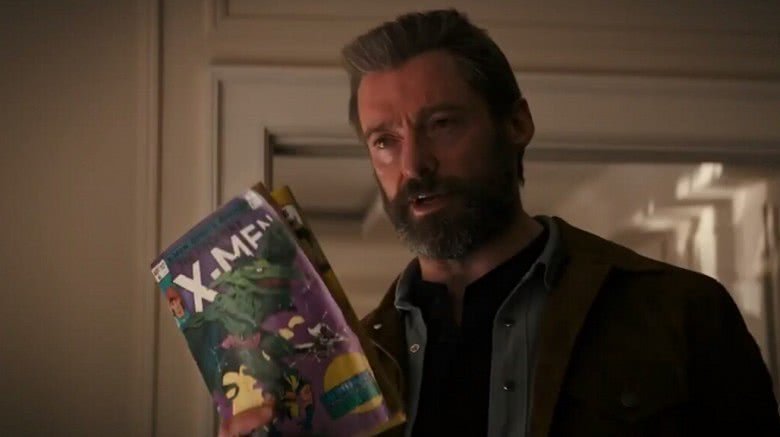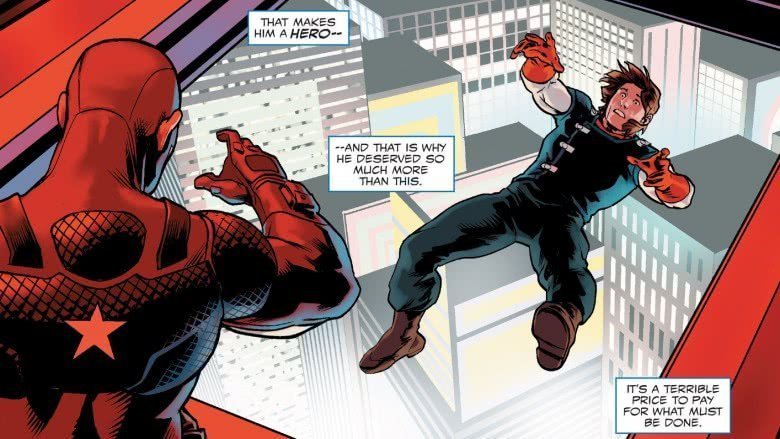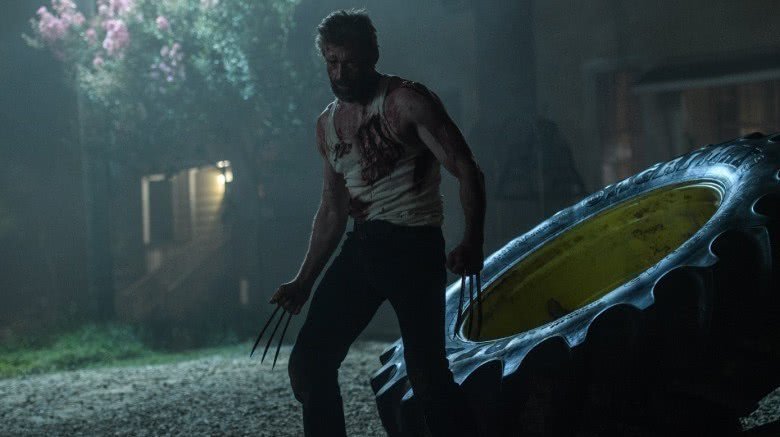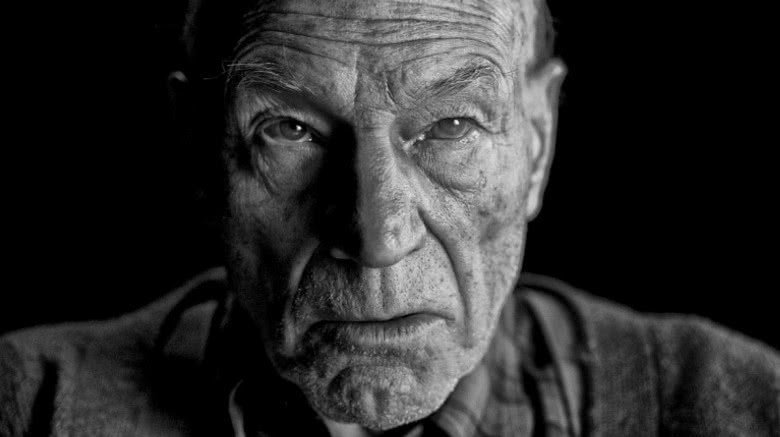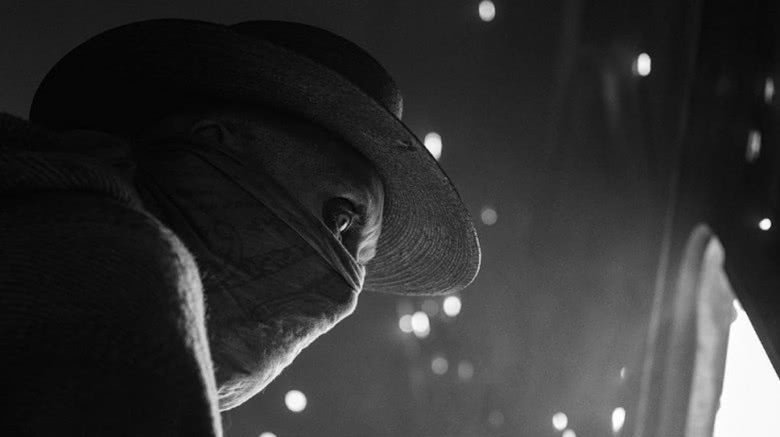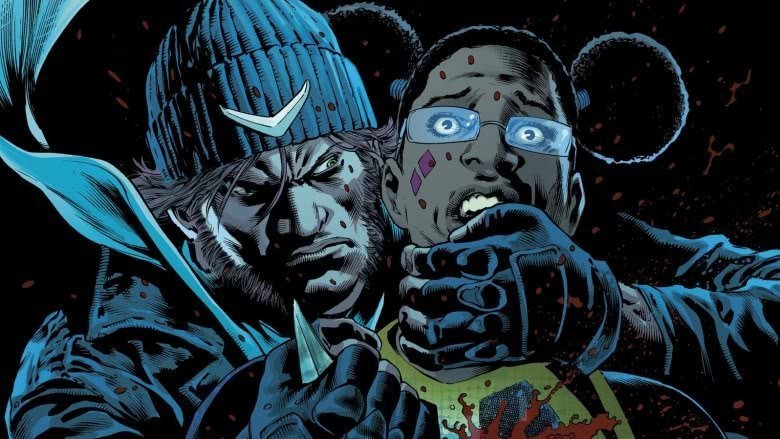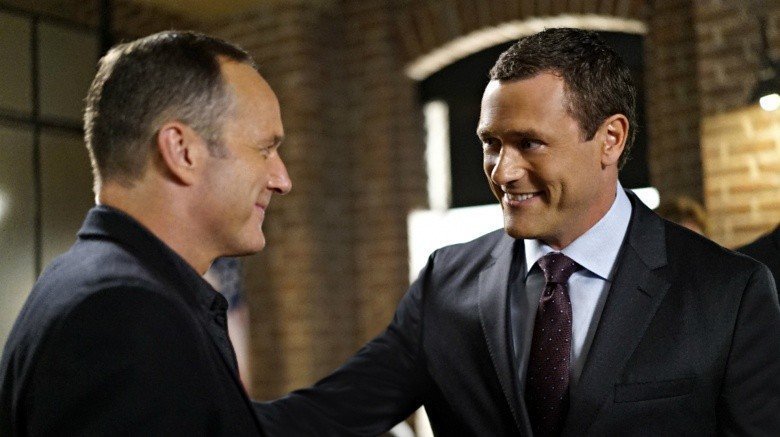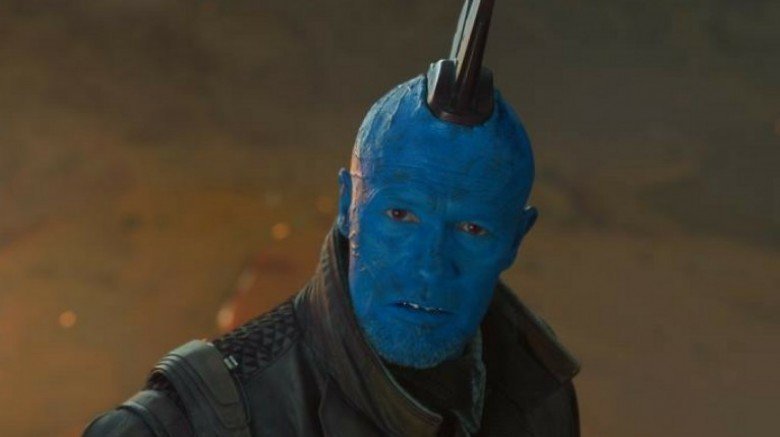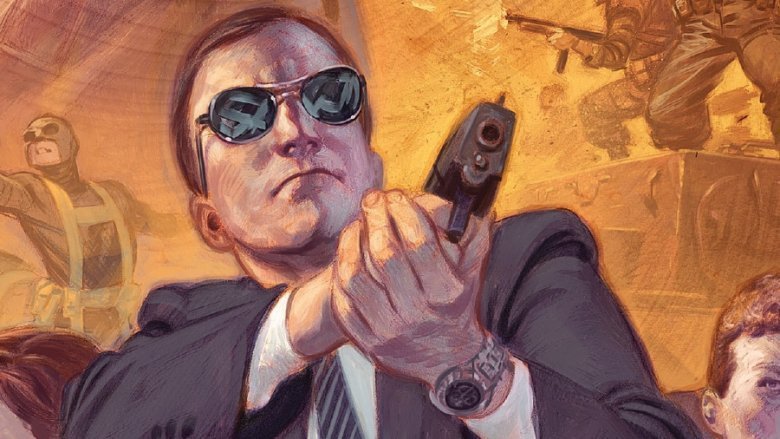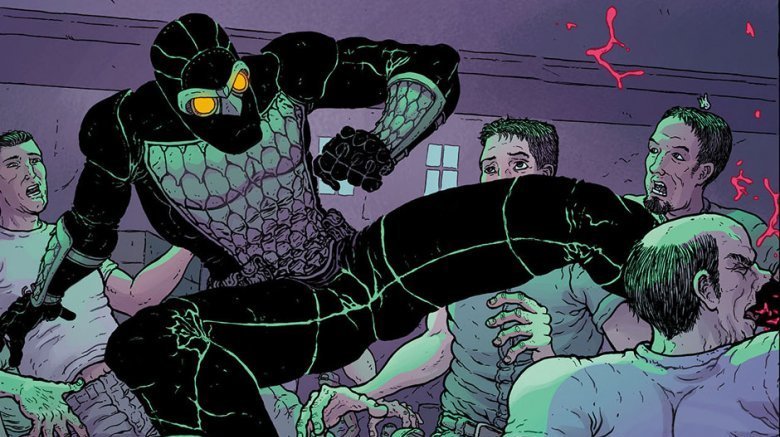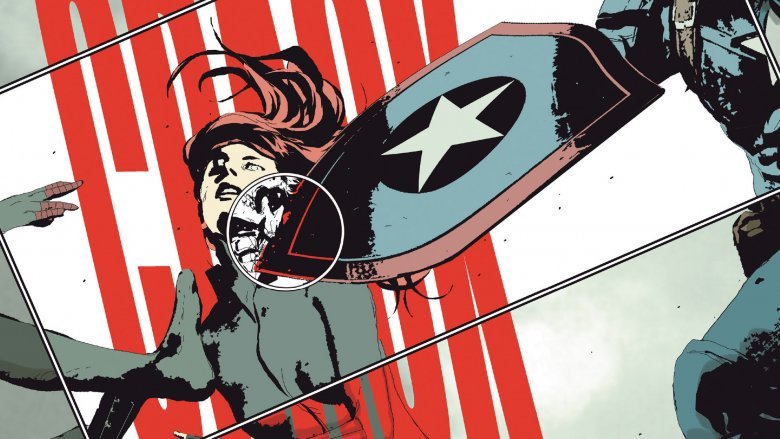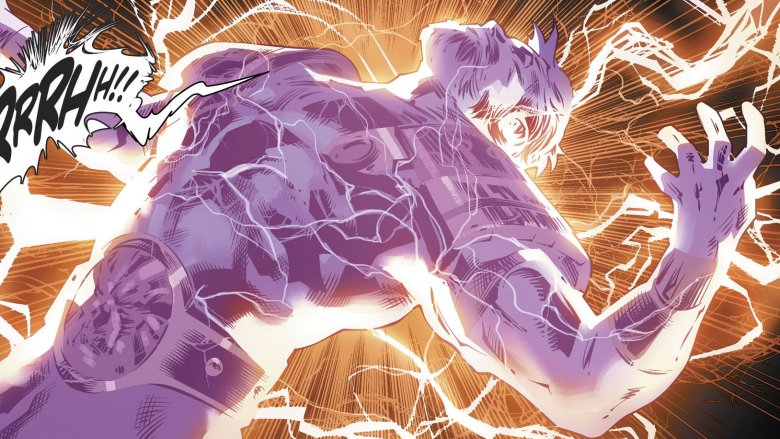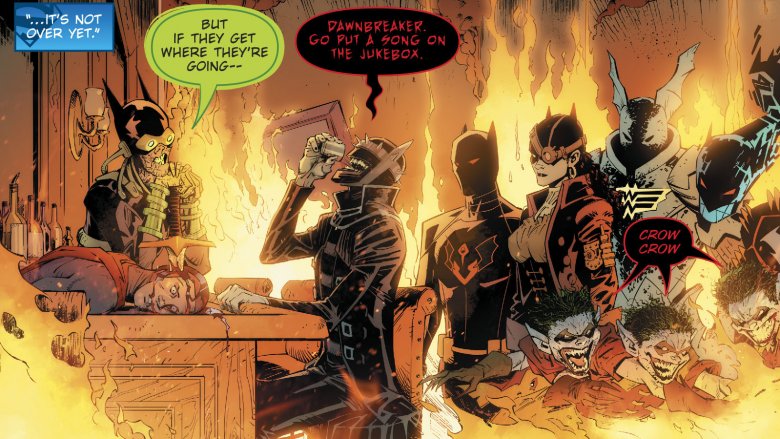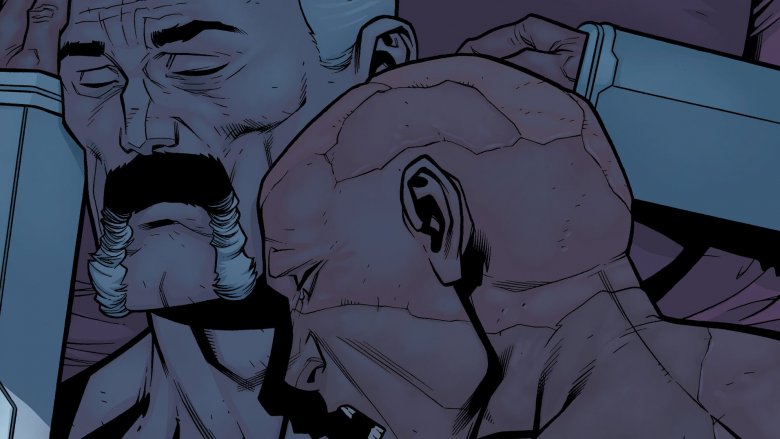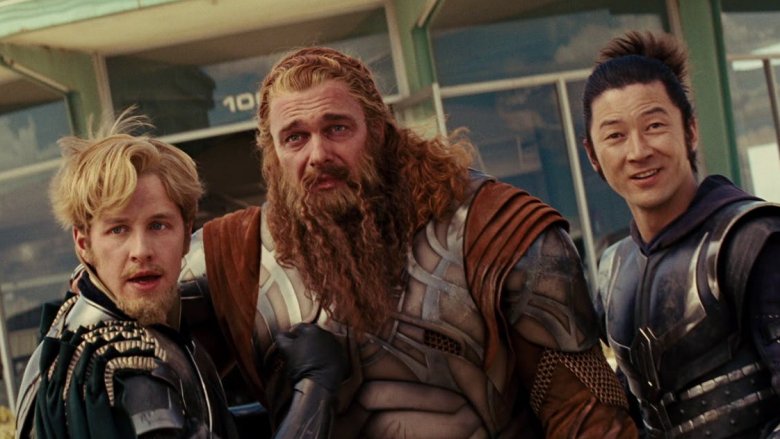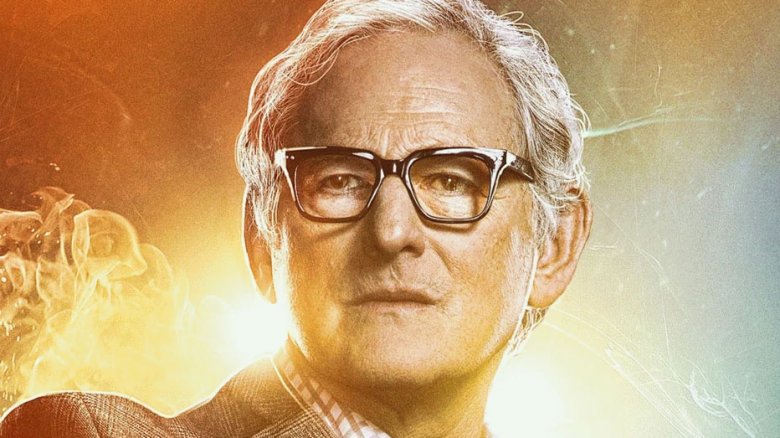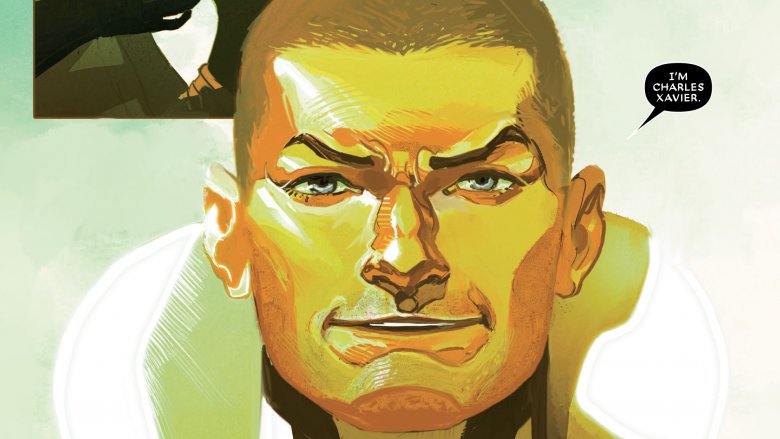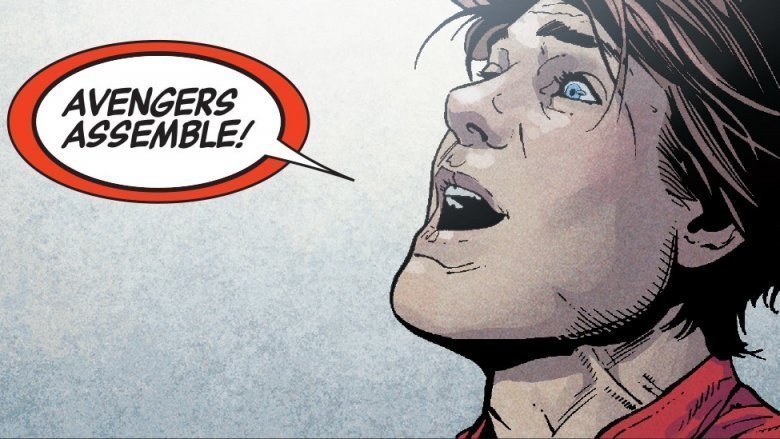Superheroes We Lost In 2017
In the world of comics, there's a little phrase, which once went a little something like this: "the only people who stay dead in comics are Bucky Barnes, Jason Todd, and Uncle Ben." Well, Bucky "The Winter Soldier" Barnes is alive and kicking butt as a member of the Thunderbolts, and Jason Todd is doing his Red Hood thing. Only Uncle Ben is actually still on the slab. In the superhero world, dead is dead until it's not. Then Marvel and DC put together their "Rebirths" and "ResurrXions" to rake in the reincarnation dough. So in the spirit of the superhero cycle, we'll remember those who lost their lives in 2017, defending the defenseless and righting the wrongs, at least until they make their triumphant return next week. Fair warning, serious spoilers ahead.
Jack Flag (Captain America: Steve Rogers #10) January 25, 2017
Did you know Captain America is a bad guy in the comics? Seriously, he's actually an agent of Hydra now. However, it wasn't a conscious decision on his behalf. He was saved from death by a 7-year-old girl named Kobik, who is actually a Cosmic Cube—basically, an extremely powerful Marvel Universe-based wish-fulfillment device—and had his wires scrambled to think the fascistic organization was all rainbows and unicorns. Comics. Anyhow, since then, Steve Rogers has toiled steadily to undermine the world for the glory of Hydra. Good times. In any case, you might be reasonably wondering, what does this have to do with Jack Flag?
Flag, otherwise known as Jack Harrison, first hoisted his banner in 1994's Marc Gruenwald-penned, Dale Hoover-drawn Captain America #434. Originally a member of Cap's see-some-bad-stuff-report-it computer hotline (the Star-Spangled Avenger was ahead of the curve), he and his brother Drake formed a citizen's patrol group. When they fought to take down the Serpent Society in Arizona, he picked the code name Jack Flag. Initially, Flag was just a really buff dude with some serious butt-whooping skills until he was accidentally drenched with superpower juice during a brawl with archfiend Mr. Hyde. Although never an extremely prominent player, Flag popped in and out of the Marvel Universe, even keeping the cosmos safe as a member of Guardians of the Galaxy for a time.
Upon his return to Earth, Steve recruited him to join S.H.I.E.L.D. and work alongside his on-again, off-again cohort and Captain America protege Cathy Webster, aka Free Spirit. Unfortunately, the patriotic protagonist didn't realize that Cap was playing for the bad guys now. While tracking down longtime antagonist Baron Helmut Zemo, Flag disobeyed Rogers' orders and whipped the supervillain. As he and Steve soared off into the presumable happy-ending sunset, Cap revealed his true Hydra loyalties, before tossing his former friend and colleague out of the plane to his death. Flag managed to survive the fall, but sadly, remained braindead on life support, until his former partner Cathy (and his family) decided to pull the plug—that is, just before Steve could slip poison in his i.v.—in Captain America: Steve Rogers #10.
Oh Cap, you've been retconned into such a bad, bad man.
Logan (Logan) March 3, 2017
Throughout the world of gritty antiheroes, few characters are as beloved as Wolverine. First baring his adamantium claws in The Incredible Hulk #180, James Howlett made a big, bloody splash in spite of his compact yet immensely powerful frame. Gifted with the ability to heal at incredible rates (and consequently a really long life), superhuman reflexes, and keen tracking skills, the already powerful mutant was then further enhanced by the Weapon X program—imbuing him a nearly indestructible adamantium skeleton and his signature claws. His career as an X-Man, as well as his tours of duty with Alpha Flight, the Avengers, and X-Force, are legendary in the superhero world and carried over well on the big screen.
Logan debuted onscreen in Bryan Singer's popular X-Men, which was also the vanguard of the cinematic superhero revolution to come. Initially decried by fans not only for his 6-foot-plus height (Wolverine is considerably shorter in the comics), Hugh Jackman quickly put doubts aside and became the face of the character. He's now portrayed the mutant berserker through nine films—ten if you count his magazine cutout mask in Deadpool—over 17 years, including three solo outings: X-Men: Origins–Wolverine, The Wolverine, and his final curtain call in Logan.
Long ago, Jackman announced his departure from the X-Men following director James Mangold's grim and haunting film. Fox's second successful R-rated superhero flick, Logan heads to the near future, where mutant-kind has all but disappeared from the planet. Wolverine is now past his prime and losing his healing power, watching after his degenerating former mentor, Charles Xavier. He's convinced to leave the old mutant folks' home to help Laura Kinney, a preteen genetic duplicate who becomes like a daughter to him. They're on the run from twisted genetic manipulators Transigen, but the company's goons catch up with the band near the Canadian border.
He makes a final stand in the woods, trying to protect the clone kids, who hope to make a new life in "Eden" from his feral duplicate, X-24. In an emblematic moment, Logan kills his violent former self, but in doing so, is impaled on a tree stump. While Wolverine's life ends violently, much like he lived it, he also goes out on a high note, protecting the future of mutant kind and imploring his "daughter" Laura not to make the same mistakes he did—the truest fatherly way imaginable.
Professor Charles Xavier (Logan) March 3, 2017
As the founder of the Xavier Institute for Higher Learning, Charles Xavier first appeared in Stan Lee and Jack Kirby's The X-Men #1 way back in 1963. Although confined to a wheelchair, Professor X is anything but limited, as he's instilled with incredible hope and mind-blowing telepathic powers, which he uses promote peace and understanding throughout the Marvel Universe. His genius-level intellect also allowed him to invent Cerebro, a computerized helmet that enhances his already off-the-chain psychic skills. Under his tutelage, countless X-Men have honed their superhuman abilities for the benefit of humanity and mutantkind.
Patrick Stewart may not have chalked up as many X-Films as his longtime costar Hugh Jackman, but he's been killing it as Charles Xavier for just as long, ever since Bryan Singer's 2000 franchise-starter X-Men. Since then, Stewart retained the role throughout X2 and X-Men: The Last Stand, as well as returning for the tongue-twister timeline of X-Men: Days of Future Past. Although Stewart was later replaced by younger actor James McAvoy—even if no one can truly "replace" Stewart—during the X-Men: First Class trilogy, Stewart remains the definitive Professor X for many fans. After Days, though, Stewart agreed to (at least) one more definitive outing for classic Professor X. That outing came in Logan.
In Logan, Xavier is far removed from the proud, headstrong, and powerful mutant leader from previous outings. This version is old and infirm, suffering from a degenerative disease that causes him to lose control of his mental telepathy—which at his power levels, can cause some serious damage. Now, Logan watches out for his former mentor like a son would a father, something that makes his final end all the more heartbreaking. While running from cyborg antagonist Donald Pierce and his Reavers, Xavier and his crew flee to the sparse countryside. Holed up with a farm family, Wolverine's clone X-24 catches up to the group. Mistaking X-24 for Logan, an easy mistake to make for the ailing professor, Xavier confesses to causing a telepathic incident—one that may have killed numerous X-Men. Unfortunately, the mutant clone has no interest in an old man's dark anecdotes and stabs Xavier through the chest. Logan returns as his longtime friend succumbs to his injuries, and, despite the tragic nature of his death, there's something appropriate about the Professor passing in the arms of his prodigal pupil.
Footnote: Although his comic book counterpart has been deceased for half a decade, a portion of his brain lived on in Red Skull's now-telepathic mind. In Uncanny Avengers #22, though, the X-Men extracted Xavier's brain and cremated it. Rest in pieces and in peace, chunks of Charles' brain.
Caliban (in Logan March 3, 2017)
A true "child" of the '80s, Caliban first appeared in 1981, created by Chris Claremont for Uncanny X-Men #148. Born an albino and a mutant, he was ousted from his home and nicknamed after the monstrous wild man from William Shakespeare's The Tempest by his clearly loving father. Caliban is also gifted with an incredible tracking ability, which allows him to ascertain the whereabouts of his fellow mutants. Eventually, the young man is discovered by fellow X-gene-enabled Callisto, who uses him to find other disenfranchised mutants and start the Morlocks. Caliban survives the slaughter of the group by the Marauders and bounces around the X-Men world, as well as the general Marvel Universe, for the next few decades.
Caliban's film life is significantly shorter than his comic book one. Portrayed by two different actors, he initially appeared in X-Men: Apocalypse as a black market information dealer with hardcore psychic-ninja Psylocke watching his back. For his next outing, though, Steven Merchant played the pasty mutant, who is initially co-opted by the Transigen Corporation to seek out the remnants of mutantkind in the near future. Once he realizes the terrible consequences of his actions, he bolts from the twisted cloners. Logan eventually finds him and asks him to help watch after Professor X, who's losing his faculties. Eventually, Donald Pierce and his Reavers recapture Caliban and make him to track down Wolverine, his clone Laura, and Xavier. Despite his loosely duplicitous actions in Logan, Caliban manages to redeem himself in the end. Giving Logan and Laura a shot to escape, he swipes a couple of grenades, blowing himself and several Reavers all to cyborg bits.
But it's not hard to see how he could return to the film world. In the likely event of a sequel or spinoff from the otherwise standalone story, Dafne Keen's Laura Kinney will probably carry on as X-23 or even as Wolverine. We already know Transigen is experimenting with Caliban's genes due to his abilities and powerful intellect, so he could make a comeback. It is a comic book-based movie, after all.
Hack (Suicide Squad #13) March 8, 2017
In the world of comic books, death is as inevitable as it is in the real world. On the other hand, comic deaths are also often presaged by a couple dozen promos and even a news feature or three—at least, if you're a bigwig like the Hulk or Superman. Lower-level superheroes, on the other hand, usually find themselves introduced only to fade into obscurity or get chuffed off like a red shirt on Star Trek. Perhaps it hurts far less to lose someone you've just met. In either case, Hack, we hardly knew ye.
First introduced in the second issue of the Suicide Squad "Rebirth," Zalika, aka Hack, was a tech-savvy metahuman, also pithily referred to as a technopath. The young woman grew up in the Korogocho slums on the outskirts of Nairobi, Kenya, and was forced to work for gangs as a hacker, at least until discovering her burgeoning abilities. Her unique powers allowed her to surf the web without any devices, teleport through the internet, and download or upload files directly from her own mind. Eventually, she's captured and sent to the super-secret Temho-Metya Prison, which is where the Skwad finds her.
She helps Task Force X escape their metahuman prison and return to their other prison/home base at Belle Reve. A fast favorite, she signs on, eventually finding a compatriot in the unstable if charming Harley Quinn. Her high-tech hijinks help the team break into the Black Vault, where they find the brooding Kryptonian General Zod. She also gives them a leg up against their anti-establishment foe (and one-time leader) Rustam. Hack discovers a traitor in their midst, but unfortunately, turncoats Captain Boomerang and Agent Harcourt are one step ahead of her. With a smidgeon of regret, Boomerang stabs the young techie through the heart, killing her before she can fully emerge from her heroic chrysalis.
While Hack may have been a member of the Suicide Squad, technically made up of villains, she more than proved herself a hero—even being christened as such by the morally ambiguous Ms. Quinn, for what it's worth. And just like that, Zalika (which means well-born in Swahili) is gone forever. (OK, "forever" is probably a stretch.)
Patriot (Agents of S.H.I.E.L.D.) April 18, 2017
When it comes to classic superheroes, it doesn't get much more old school than Jeffrey Mace, The Patriot. Timely Comics—soon to become a little company known as Marvel—debuted its second-string red, white, and blue hero in 1941, alongside Jim Hammonds, the original android Human Torch in the aptly named The Human Torch #3. Mace was also the third Captain America—in addition to being the longest-running Star-Spangled Avenger, after Steve Rogers, of course—carrying the shield from 1946 to 1952. Since then, Patriot has bounced around the pages of Marvel, reappearing in flashbacks and as a minor character. He even gained two legacy heroes over the years in Eli Bradley and Rayshaun Lucas.
Transitioning from the comic book pages to the small screen, Patriot (played by Jason O'Mara) dropped into Marvel's fourth season of Agents of S.H.I.E.L.D. as the new director, a purported Inhuman with some supposedly nifty powers. But it was all a ruse. The Patriot was a pretender to his Kree-enhanced genes, while actually being a part of a Captain America-like super-soldier program (tomato-tomahto, power-wise).
Mace later proved that he was a true hero, at least in the virtual reality program known as the Framework, where he also exhibited actual Inhuman powers. During the aptly titled episode "No Regrets," he assisted in an extrusion of his agency-mates from the Framework. When Madame Hydra (Mallory Jansen) blows up the building they're in, Mace uses his now-activated skills to selflessly protect his fellow agents and a bunch of children, allowing them to escape before the building collapses. Unfortunately, the Framework, which operates much like Freddy Krueger's dream-scapes in Nightmare on Elm Street, equates to a real-world flat line for the director, er, former director.
S.H.I.E.L.D. really chews up and spits out its head honchos. No wonder Agent Coulson wasn't nipping at the bud for his directorship back.
Yondu Udonta (Guardians of the Galaxy Vol. 2) May 5, 2017
To most people, Yondu was the gruff if honorable—for space pirates, anyway—blue alien from the movie with the talking raccoon and the adorable, monosyllabic tree-beast. Guardians of the Galaxy introduced the world to Peter Quill's abductor, the craggy, drawling Ravager who taught Star-Lord everything he knows about conniving and swiping stuff, who's also a wizard with that deadly, whistling spear-thingy (it's called a Yaka Arrow, by the way). As somewhat obscurely revealed in Guardians of the Galaxy Vol. 2, Yondu Udonta's history is deeper than we suspected.
Comic book fans, on the other hand, know his true background as a core member of the original team. Yondu got his start in the first appearance of the team in 1969, in Marvel Super-Heroes #18. Created by Arnold Drake and Gene Colan, he was a member of a "primitive" band of Alpha Centauri IV natives. After his home world was razed by the Badoon, Yondu sought revenge and a way to escape his lonely existence as the last of the Zatoan tribe. Befriending the appropriately named, time-displaced rocketeer Vance Astro, Yondu helped rid the space lanes of alien riffraff, co-founding the cosmic defenders alongside Astro, Stakar and Aleta Ogord (Starhawk(s), it's complicated), Charlie-27, and Martinex.
For the first volume of Guardians, Yondu was repurposed as one of the film's primary antagonists. Betrayed at the end by Peter, over the blatantly monikered Power Stone, a.k.a. "The Orb," he had a change of heart in the sequel. Unfortunately, his choice to show Star-Lord mercy kicks off the Ravager mutiny which frames the action in GotG2. Eventually, he reveals himself as a pirate softie, teaming up with Pete and crew to defeat Ego the Living Planet. While escaping the evil planet's demise, the former Ravager gives the last spacesuit to his surrogate son, sacrificing himself for Star-Lord while redeeming himself in the eyes of his former Ravager colleagues. To quote Peter's "moving" eulogy:
"Yondu didn't have a talking car, but he did have a flying arrow. He didn't have a beautiful voice of an angel, but he did have the whistle of one. Both Yondu and David Hasselhoff went on kickass adventures and hooked up with hot women, and fought robots. I guess David Hasselhoff did kinda end up being my dad after all, only it was you, Yondu...I had a pretty cool dad."
Agent Phil Coulson (Deadpool #31) May 31, 2017
One of the few characters created for the Marvel Cinematic Universe that jumped into other media, Phil Coulson has a relatively unique place in the Marvel Universe. The sardonic agent, played by Clark Gregg in movieland, transitioned from Iron Man in 2008, making the leap from film to print in 2012's Battle Scars #1. Coulson's popularity also landed him a recurring role on ABC's Agents of S.H.I.E.L.D.
Since his comics debut, Coulson has appeared across several titles. The Battle Scars limited series revealed his past as an Army Ranger in Afghanistan, as well as his recruitment into S.H.I.E.L.D. He also starred in the AoS spinoff comic, enjoying cameos and guest-starring spots—much like the film world—in a variety of titles and major events like Civil War II and the lead-up to Secret Empire.
Speaking of the latter, Agent Coulson followed his hunches about his hero, Captain America, stumbling across the onetime hero's true allegiances to Hydra. Naturally, that was a loose end HydraCap couldn't abide, so he sent Deadpool—who like Coulson, has always idolized Cap—to take him out. Wade blasted him out of the sky and put a bullet in his chest before burning Phil's safehouse to the ground. Of course, Agent Coulson officially "died " in The Avengers, which clearly didn't take. While his death was never visually confirmed, a chest wound and roaring inferno are pretty tough to recover from, even for secret agents.
Nighthawk (Occupy Avengers #8) June 28, 2017
Kyle Richmond began life as a Batman knockoff known as Nighthawk. Previously a wealthy dilettante, Kyle jumped at the chance to superhero out when the Grandmaster assembled a team to take on the Avengers. He and the Squadron Sinister first battled Earth's Mightiest Heroes in Avengers #69. Later, he broke into the world of solo crimefighting, occasionally reuniting with his fellow DC ringers on the team now called the Squadron Supreme.
When Marvel's multiverse collapsed during Secret Wars in 2015, an alternate version of Richmond—developed in the mature-audience Max series, Supreme Power—escaped his home universe's destruction. To avoid confusion with his Prime Earth counterpart, he changed his name to Raymond Kyle. Eventually, he landed a standalone series from acclaimed writer David F. Walker, which offered an unflinching look at urban violence in Chicago. After its cancellation, Nighthawk also dropped by Walker's Occupy Avengers book on occasion.
Occupy Avengers #8 reveals that his longtime colleague, Tilda Johnson, is carrying on his name (and owlish gear). In the issue, she laments his passing, noting that he was shot and killed during an out-of-uniform scuffle with Hydra's goons. Of course, since the events of Secret Empire themselves could wind up magically erased thanks to a Cosmic Cube, Nighthawk may yet don his distinctive garb in the not-too-distant future.
Black Widow (Secret Empire #7) July 26, 2017
Life's been hard for Natasha Romanova. She grew up in a secret Soviet facility called "The Red Room" where her handlers brainwashed her and taught her to be a top-notch assassin. She fought Iron Man in her villainous debut back in Tales of Suspense, joined the Avengers and the Champions a few years later, and hooked up with Hawkeye, Daredevil, and the Winter Soldier. She then helped Tony Stark enforce the Superhero Registration Act in Civil War, and she led a team of superheroes in a fight to free America from Hydra and Captain America's clutches in Secret Empire.
That last fight would be her final one, although to get the full story, you need to go back a year or two. In Civil War II, an Inhuman who can see the future shares a vision with Marvel's heroes. In it, Miles Morales stands on the steps of the US Capitol, his costume soaked in blood, clutching Captain America's lifeless body. It's a provocative image, and yet it took a while to get more information. Civil War II ended without explaining things further, and then everyone got very busy when Captain America revealed that he was a Hydra sleeper agent, took over S.H.I.E.L.D., and conquered the United States.
Finally, in Secret Empire #7, Miles and Steve Rogers met face-to-face—but neither of them counted on Natasha. While Cap and Spider-Man squared off, the Black Widow watched on a nearby roof with a sniper-rifle, hoping to end Captain America's reign with a single bullet. When the fight broke out, Black Widow intervened, hoping to save Spider-Man. Captain America's shield broke Natasha's neck. She died on the spot. Not even the Cosmic Cube, which restored the Captain America that we all know and love and fixed most of his doppelgänger's damage, could bring Black Widow back—her funeral takes place in Secret Empire #10.
Hercules (Wonder Woman #31) September 27, 2017
We haven't seen DC's take on Hercules—also known as Heracles—for a while. In fact, the son of Zeus (and, therefore, Wonder Woman's half-brother) hasn't been seen since DC took a hatchet to its complicated, labyrinthian continuity in series like Flashpoint, DC Rebirth, and The New 52. Previously, Hercules had the singular honor of being the first man to set foot on Themyscira, briefly dated Hippolyta, the queen of the Amazons, adopted the name "Harold Champions" for his human secret identity, and helped Wonder Woman capture her arch-nemesis, Circe.
Before all of that happened, of course, Hercules captured and raped Hippolyta (as per the original Greek myths), and in his last appearance he teamed up with the Female Furies to take out Wonder Girl. In other words, Hercules was a complicated guy. Let's leave it at that.
Not that any of it matters, of course. In Wonder Woman #31, Hercules' first appearance in the post-Flashpoint timeline, the demigod makes his big debut—again—as a god-in-hiding. Posing as a lumberjack in the Pacific Northwest, Hercules is trying to live a regular, human life. Darkseid's daughter, Grail, has other plans for him. After a prolonged battle, Grail kills Hercules and steals his power, which she uses to help her father, who was recently reincarnated as a child, to grow up a little faster. Hercules leaves his fortune to Wonder Woman and shuffles off the mortal coil—at least for now.
Nightmaster (Dark Nights: Metal #3) Oct 11, 2017
Nightmaster may not be a household name like Superman, Batman, or Wonder Woman, but that doesn't make his sacrifice in Dark Nights: Metal any less poignant. Well-known or not, Nightmaster went out like the hero that he is, and should be celebrated as such.
In 1968's Showcase #82, a rock and roll singer named Jim Rook found himself mysteriously transported to Myrra, a fantasy world engulfed in a battle between the forces of evil, known as the Warlocks, and Myrra's leader, King Zolto. Reluctantly, Rook claimed the sword that used to belong to Myrra's legendary hero, Nacht—conveniently, one of Rook's long-lost ancestors—and fought off the Warlocks, saved Myrra, and returned home.
Ever since, Nightmaster's been lurking on the edge of DC Comics' shared superhero world, lending aid to various heroes as the proprietor of the Oblivion Bar, a magical watering hole tucked away in its own private dimension. He briefly joined the superhero team Shadowpact, which was established in the lead-up to DC's mega-crossover Infinite Crisis, teaming up with heroes like Enchantress, Detective Chimp, and Ragman to battle various magical threats. Mostly, however, Nightmaster's best known as an armor-clad bartender whose main mission is providing mystically-gifted heroes a place to down a few drinks and relax.
That changed in Dark Nights: Metal #3, when the DC Universe's remaining heroes retreated to the Oblivion Bar to plan a strike against the invading forces from the Dark Multiverse. It's the last meeting the Oblivion Bar will ever host. While the good guys rescue Superman, they lead Barbatos' Dark Knights, led by the Batman Who Laughs, right to the Oblivion. As the rest of the heroes flee, Nightmaster stands his ground, delaying the twisted Batmen until everyone else can escape. It's a noble gesture, and one that Nightmaster pays for with his life.
Omni-Man (Invincible #141) October 18, 2017
After nearly 150 issues, Robert Kirkman's (The Walking Dead, Outcast) breakout title Invincible is quickly winding down—and if you've been reading along this whole time, then you know that things are going to get very, very bloody before the end. In fact, they already have. Mark Grayson, the half-human half-Viltrumite hero better known as Invincible, has led the galaxy's superheroes in an all-out battle against Thragg, the power-hungry leader of a rogue Viltrum army. After a prolonged battle, Mark and Thragg duke it out inside of a burning sun, and while Mark emerges victorious, his side doesn't escape without some major losses. Mark's brother, Oliver, dies during the conflict. In Invincible #141, Mark's father, Nolan, succumbs to injuries that he suffered during the fight.
The death of Nolan is a big loss for Mark, Earth, and Invincible itself. When Invincible launched way, way back in 2003, Nolan—known at the time as Omni-Man—was the cornerstone of the book. Initially Invincible asked the question, "What would happen if Superman had a son?," and followed that up with a series of fun and light adventure stories that showed Mark embracing his newfound powers and fighting crime alongside his old man.
After a year, Invincible changed. Omni-Man turned out to be a traitor with plans for conquering Earth, and Invincible had to stop him. That wasn't the end of Omni-Man's story. Thanks to Mark's influence, Nolan went from a pretend hero to a real one. After a long, hard road, Omni-Man reemerged as a force for good and took the reigns of a newly formed, much more peaceful Viltrumite Empire. With Omni-Man's redemption and death, Invincible's first and most important conflict is finally over—although, with two issues left, Invincible still has a few problems to sort out before the end.
The Warriors Three (Thor: Ragnarok) November 3, 2017
In Thor: Ragnarok, Thor saves most of the Asgardians from Hela, goddess of death, with help from Hulk, Valkyrie, Loki, Heimdall and some of his new friends from the planet Sakaar. He doesn't rescue everyone, though: the Warriors Three, Thor's rambunctious sidekicks, fight on the front lines when Hela attacks. Not a single one of them survives the film.
In fact, given the Warrior Three's prowess, the trio of battle-hardened Asgardians go down very, very quickly. Volstagg (i.e. the fat one) is offed almost immediately while trying to figure out who Hela is and moving to arrest her. When Fandral tries to avenge his lost friend, he's put down too. It happens so fast that it's hard to tell if Chuck and Shazam star Zachary Levi is reprising his role as the character, or if Fandral's been recast again (in case you missed it, that is in fact Levi under the mustache and goatee).
At least Hogun the Grim gets a proper sendoff. As Hela's forces march through Asgard and conquer the city, Hogun decides to step up. It's the last thing that he ever does. Marvel Studios president Kevin Feige explained during a press junket that the idea was to make sure Hela's debut became "the arrival of the biggest villain into the MCU" (as if shattering Thor's hammer wasn't enough), but that's an awfully bloodthirsty way to do it. At least Lady Sif is safe—for now.
Martin Stein (Legends of Tomorrow) November 28, 2017
Any Legends of Tomorrow fan who was paying attention knew that Dr. Martin Stein, better known as Firestorm's older half, was on the way out. In October, right before Legends returned for its third season, Deadline announced that actor Victor Garber, who plays Stein, would be leaving the show so he could replace David Hyde Pierce in Broadway's Hello, Dolly! revival.
Legends started planting the seeds for Garber's departure immediately. Early on, Stein's daughter gives birth, and the genius scientist decides he wants to stop adventuring and spend more time with his family. A running subplot during the first half of the season chronicles Stein's attempts to devise a way to separate himself from Jefferson Jackson, the young man he's bonded to thanks to the Firestorm matrix.
In the four-part crossover special Crisis on Earth X, it looks like Martin's found his way out. Some of his peers help to devise a serum that'll separate Stein and Jackson, leaving them both powerless but free of responsibilities. By all indications, Stein is set for both a graceful exit and a happy ending.
And then, Nazis happen. While trapped on an alternate Earth where the Third Reich conquered the world, Martin sacrifices his body to open a portal that'll send his friends home. As Martin succumbs to gunshot wounds, Jackson merges with him, creating Firestorm. That keeps Stein alive for a little while, but also puts Jackson in harm's way. In order to save his protégé's life, Stein forces Jackson to give him the serum, severing their psychic link. Martin dies a few minutes later, leaving Jackson with one last heroic task to perform: delivering the news to Stein's distraught family.
Fantomex (Astonishing X-Men #6) December 6, 2017
Five years after Cyclops killed him in a Phoenix Force-fueled rage, Charles Xavier is back—or at least his mind is. As revealed in Astonishing X-Men's first arc, the Shadow King stole a part of Professor X's soul, and then spent thousands of years (or, at least, what felt like a thousand years) challenging him to a non-stop psychic duel on the astral plane.
But Xavier is a clever and humble man, and he's not afraid to ask for help when he needs it. While battling the Shadow King, Professor X convinces the villain to let some of Marvel's merry mutants travel to the astral plane to serve as pawns in their "game." The Shadow King agrees, and before long Gambit, Rogue, Mystique, Old Man Logan, Fantomex, and others are battling alongside their former mentor in hopes that the good side will win.
Mystique and Fantomex use the astral plane's rewritable reality to have some fun before the real fight starts, but when it's time to get dirty, they've got no problem helping Chuck take the Shadow King down for good—and restore the professor to life in the process. But resurrection comes with a cost. Xavier's spirit might be intact, but his old body is toast. Fantomex offers up his as a form of penance for his past misdeeds. When the dust clears, Fantomex is gone, and Charles Xavier has a new identity—and a rad new body to along with it.
Super Friends RIP
Rick Jones (Secret Empire #1) May 3, 2017
First drawn up in 1962, Rick Jones started life as a rogue teen on the wrong end of a Gamma bomb—he was effectively the man who inadvertently turned Bruce Banner into the Hulk in Incredible Hulk #1. His adventures continued in the pages of Marvel, galvanizing the Avengers into action in Avengers #1—thanks to his Teen Brigade ham radio broadcast—as well as sidekicking for Captain America (as a legacy Bucky Barnes), with the male Captain Marvel, and of course the Hulk. Aside from becoming an honorary Avenger and working for S.H.I.E.L.D., Rick became gamma radiation-powered hero A-Bomb for a time as well.
At the dawn of Captain America's fascist state, Rick was captured for hacking into Hydra computers—using an iPhone, no less. The information he swiped has the power to possibly reverse Cap's transformation and aid the resistance in their fight against the terrorist takeover. Unfortunately, it also cost Jones his life. Despite Cap's waffling, Jones is executed via firing squad in Secret Empire #1, as the first casualty of the event. Rick goes out as the true hero he is, though, yelling "Avengers Assemble" before his death.
Stick (The Defenders) August 18, 2017
Without Stick, there'd be no Daredevil. First introduced in Daredevil during Frank Miller's legendary run, Stick—like Matt Murdock—developed heightened senses in order to compensate for his missing eyesight. Next, he climbed through the ranks of the Chaste, a band of accomplished martial artists, and led the battle against the gang of evil assassins known as The Hand. When young Mr. Murdock was blinded in a freak accident, Stick took him in and showed him how to fight. Later, when Murdock's girlfriend, Elektra, needed help, Stick taught her too.
Stick's story made its way into Netflix's Daredevil series, too—in this version, Stick (played by veteran actor Scott Glenn) trained Elektra when she was a child, and saved her when other members of the Chaste wanted her dead. She returned the favor by killing him.
In The Defenders, Stick enlists Daredevil, Iron Fist, Jessica Jones, and Luke Cage to help defeat The Hand once and for all. It doesn't go well. When Stick learns that Iron Fist plays a crucial role in The Hand's plans, he sets out to kill Danny Rand—but doesn't manage to succeed before Elektra stabs him in the chest, ending his mission prematurely.
